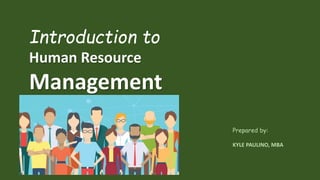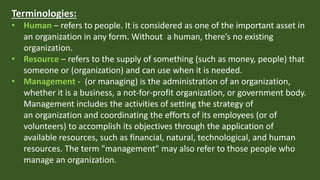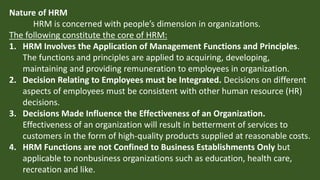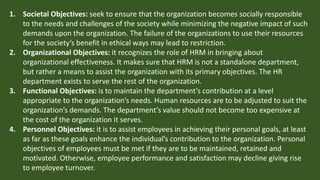Lesson-1-Introduction-to-HRM.pptx
- 1. Introduction to Human Resource Management Prepared by: KYLE PAULINO, MBA
- 2. Introduction to Human Resource Management Human is one of the most important asset of any Organization and unlike other resources the human could be developed and increased to a limitless extent. Human resources mean the energies, skills, knowledge and physical strength of the people at work. Today, companies offer their products and services with the highest quality as possible to be competitive. In order to remain competitive, to grow, and diversify, an organization must ensure that its employees are qualified, placed in appropriate positions, properly trained, managed effectively, and committed to the firm’s success. Therefore, the only thing that will uphold a company’s advantage tomorrow is the caliber of people in the organization.
- 3. The goal of HRM is concerned with the “people” dimension in management. Since every organization is made up of people, acquiring their services, developing their skills, motivating them to high level of performance and ensuring that they continue to maintain their commitment to the organization are essential to achieving organizational objectives. Those organization that can acquire, develop, stimulate and keep outstanding workers will be effective (able to achieve their organizational goals), efficient (expanding the least number of resources necessary) and economical (work with little waste or at saving).
- 4. Terminologies: • Human – refers to people. It is considered as one of the important asset in an organization in any form. Without a human, there’s no existing organization. • Resource – refers to the supply of something (such as money, people) that someone or (organization) and can use when it is needed. • Management - (or managing) is the administration of an organization, whether it is a business, a not-for-profit organization, or government body. Management includes the activities of setting the strategy of an organization and coordinating the efforts of its employees (or of volunteers) to accomplish its objectives through the application of available resources, such as financial, natural, technological, and human resources. The term "management" may also refer to those people who manage an organization.
- 5. What is Human Resource Management? Generally Human Resource Management refers to the management of people in organizations. It comprises of the activities, policies, and practices involved in obtaining, developing, utilizing, evaluating, maintaining, and retaining the appropriate number and skill mix of employees to accomplish the organization’s objectives. The goal of HRM is to maximize employees’ contributions in order to achieve optimal productivity and effectiveness, while simultaneously attaining individual objectives (such as having a challenging job and obtaining recognition), and societal objectives (such as legal compliance and demonstrating social responsibility). In short Human Resource Management (HRM) can be defined as the art of procuring, developing and maintaining competent workforce to achieve the goals of an organization in an effective and efficient manner.
- 6. Nature of HRM HRM is concerned with people’s dimension in organizations. The following constitute the core of HRM: 1. HRM Involves the Application of Management Functions and Principles. The functions and principles are applied to acquiring, developing, maintaining and providing remuneration to employees in organization. 2. Decision Relating to Employees must be Integrated. Decisions on different aspects of employees must be consistent with other human resource (HR) decisions. 3. Decisions Made Influence the Effectiveness of an Organization. Effectiveness of an organization will result in betterment of services to customers in the form of high-quality products supplied at reasonable costs. 4. HRM Functions are not Confined to Business Establishments Only but applicable to nonbusiness organizations such as education, health care, recreation and like.
- 7. Scope of HRM The scope of HRM is indeed extensive. All major activities in the working life of a worker – from the time of his or her entry into an organization until he or she leaves the organizations comes under the purview of HRM. The major HRM activities include HR planning, job analysis, job design, employee hiring, employee and executive remuneration, employee motivation, employee maintenance, and employees' industrial relations, health and safety. The scope of Human Resources Management extends to: • All the decisions, strategies, factors, principles, operations, practices, functions, activities and methods related to the management of people as employees in any type of organization. • All the dimensions related to people in their employment relationships, and all the dynamics that flow from it.
- 8. SCOPE OF HRM
- 9. Nine Broad Areas of Activities of HRM 1. Human Resource Planning: The objective of HR Planning is to ensure that the organization has the right types of persons at the right time at the right place. It prepares human resources inventory with a view to assess present and future needs, availability and possible shortages in human resource. Thereupon, HR Planning forecast demand and supplies and identify sources of selection. HR Planning develops strategies both long- term and short-term, to meet the man-power requirement. 2. Design of Organization and Job: This is the task of laying down organization structure, authority, relationship and responsibilities. This will also mean definition of work contents for each position in the organization. This is done by “job description”. Another important step is “Job specification”. Job specification identifies the attributes of persons who will be most suitable for each job which is defined by job description.
- 10. 3. Selection and Staffing: This is the process of recruitment and selection of staff. This involves matching people and their expectations with which the job specifications and career path available within the organization. 4. Training and Development: This involves an organized attempt to find out training needs of the individuals to meet the knowledge and skill which is needed not only to perform current job but also to fulfil the future needs of the organization. 5. Organizational Development: This is an important aspect whereby “Synergetic effect” is generated in an organization i.e. healthy interpersonal and inter-group relationship within the organization. 6. Compensation and Benefits: This is the area of wages and salaries administration where wages and compensations are fixed scientifically to meet fairness and equity criteria. In addition, labor welfare measures are involved which include benefits and services.
- 11. 7. Employee Assistance: Each employee is unique in character, personality, expectation and temperament. By and large each one of them faces problems everyday. Some are personal some are official. In their case he or she remains worried. Such worries must be removed to make him or her more productive and happier. 8. Union-Labor Relations: Healthy Industrial and Labor relations are very important for enhancing peace and productivity in an organization. This is one of the areas of HRM. 9. Personnel Research and Information System: Knowledge on behavioral science and industrial psychology throws better insight into the workers expectations, aspirations and behavior. Continuous research in HR areas is an unavoidable requirement.
- 12. Objectives of HRM The primary objective of HRM is to ensure the availability of competent and willing workforce to an organization. The specific objectives include the following: 1. Human capital: assisting the organization in obtaining the right number and types of employees to fulfill its strategic and operational goals 2. Developing organizational climate: helping to create a climate in which employees are encouraged to develop and utilize their skills to the fullest and to employ the skills and abilities of the workforce efficiently 3. Helping to maintain performance standards and increase productivity through effective job design; providing adequate orientation, training and development; providing performance-related feedback; and ensuring effective two-way communication. 4. Helping to establish and maintain a harmonious employer/employee relationship.
- 13. 5. Helping to create and maintain a safe and healthy work environment 6. Developing programs to meet the economic, psychological, and social needs of the employees and helping the organization to retain the productive employees 7. Ensuring that the organization follows provincial/territorial and laws affecting the workplace (such as human rights, employment equity, occupational health and safety, employment standards, and labor relations legislation). To help the organization to reach its goals. 8. To provide organization with well-trained and well-motivated employees 9. To increase the employee's satisfaction and self-actualization 10. To develop and maintain the quality of work life 11. To communicate HR policies to all employees. 12. To help maintain ethical polices and behavior.
- 14. The above stated HRM objectives can be summarized under four specific objectives: societal, organizational, and functional and personnel.
- 15. 1. Societal Objectives: seek to ensure that the organization becomes socially responsible to the needs and challenges of the society while minimizing the negative impact of such demands upon the organization. The failure of the organizations to use their resources for the society’s benefit in ethical ways may lead to restriction. 2. Organizational Objectives: it recognizes the role of HRM in bringing about organizational effectiveness. It makes sure that HRM is not a standalone department, but rather a means to assist the organization with its primary objectives. The HR department exists to serve the rest of the organization. 3. Functional Objectives: is to maintain the department’s contribution at a level appropriate to the organization’s needs. Human resources are to be adjusted to suit the organization’s demands. The department’s value should not become too expensive at the cost of the organization it serves. 4. Personnel Objectives: it is to assist employees in achieving their personal goals, at least as far as these goals enhance the individual’s contribution to the organization. Personal objectives of employees must be met if they are to be maintained, retained and motivated. Otherwise, employee performance and satisfaction may decline giving rise to employee turnover.
- 16. Functions of HRM
- 17. HR management can be thought of as seven interlinked functions taking place within organizations, as shown in Figure. The functions can be grouped as follows: • Strategic HR Management: As a part of maintaining organizational competitiveness, strategic planning for HR effectiveness can be increased using HR metrics and HR technology. Human resource planning (HRP) function determine the number and type of employees needed to accomplish organizational goals. • Equal Employment Opportunity: Compliance with equal employment opportunity (EEO) laws and regulations affects all other HR activities. • Staffing: The aim of staffing is to provide a sufficient supply of qualified individuals to fill jobs in an organization. Job analysis, recruitment and selection are the main functions under staffing.
- 18. • Talent Management and Development: Beginning with the orientation of new employees, talent management and development includes different types of training. Training and Development programs provide useful means of assuring that the employees can perform their jobs at acceptable levels. • Total Rewards: Compensation in the form of pay, incentives and benefits are the rewards given to the employees for performing organizational work. Compensation management is the method for determining how much employees should be paid for performing certain jobs. Compensation affects staffing in that people are generally attracted to organizations offering a higher level of pay in exchange for the work performed. To be competitive, employers develop and refine their basic compensation systems and may use variable pay programs such as incentive rewards, promotion from within the team, recognition rewards, etc. This function uses rewards to motivate personnel to achieve an organization’s goals of productivity, innovation and profitability.
- 19. • Risk Management and Worker Protection: HRM addresses various workplace risks to ensure protection of workers by meeting legal requirements and being more responsive to concerns for workplace health and safety along with disaster and recovery planning. • Employee and Labor Relations: The relationship between managers and their employees must be handled legally and effectively. It is important to develop, communicate, and update HR policies and procedures so that managers and employees alike know what is expected. In some organizations, union/management relations must be addressed as well. The term labor relation refers to the interaction with employees who are represented by a trade union. Unions are organization of employees who join to obtain more voice in decisions affecting wages, benefits, working conditions and other aspects of employment. Regarding labor relations the major function of HR personnel includes negotiating with the unions regarding wages, service conditions and resolving disputes and grievances.
- 20. Role of HRM The role of HRM is to plan, develop and administer policies and programs designed to make optimum use of an organizations human resources. It is that part of management which is concerned with the people at work and with their relationship within enterprises. Its objectives are: (a) effective utilization of human resources, (b) desirable working relationships among all members of the organizations, and (c) maximum individual development. The role of HR personnel is to impart continuous education to the employees about the changes and challenges facing the country in general and their organization. The employees should know about the balance sheet of the company, sales progress, and diversification of plans, share price movements, turnover and other details about the company. The HR professionals should impart such knowledge to all employees through small booklets, video films and lectures.
- 21. Classification of HR Roles Administrative Role of HR The administrative role of HR management has been heavily oriented to administration and recordkeeping including essential legal paperwork and policy implementation. Operational and Employee Advocate Role for HR HR often has been viewed as the “employee advocate” in organizations. They act as the voice for employee concerns and spend considerable time on dealing with employee problems that are both work-related and not work-related. Employee advocacy helps to ensure fair and equitable treatment for employees regardless of personal background or circumstances. Strategic Role for HR The strategic HR role means that HR professionals are proactive in addressing business realities and focusing on future business needs, such as strategic planning, compensation strategies, the performance of HR, and measuring its results.
- 23. Paper Tower • Paper tower teaches participants the importance of planning, timing, and thinking on their feet. Please prepare sheet of paper and ten paperclips. Each group/student needs to design a freestanding tower using only the materials given. The tallest tower wins. Give the groups/student 15 minutes to work on their towers. After the time is up, take a picture of the towers and measure them. The tower must be able to stand on its own in order to qualify. Discuss why one tower might stand on its own and another fall. Point out the importance of quality in producing the towers.
Editor's Notes
- Remuneration includes the base wages, but also includes other financial compensation such as commissions, tips, and bonuses.
- Purview - the range or limit of authority, competence, responsibility, concern, or intention
- Salary is a fixed amount paid or transferred to the employees at regular intervals for their performance and productivity, at the end of the month whereas wages are hourly, or daily-based payment given to the labor for work finished in a day.
- 1. Ex. SB and Aristocrat






















